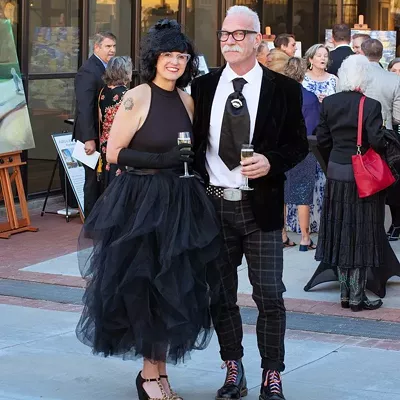Marcy Miranda Janes practices the ancient art of paper-cutting, making intricate paper landscapes that look like doilies and flowers that look like lace.
But Janes cuts with a sharp blade and more often than not her flowers are fierce.
In "Defense of Pollinators" at Contreras Gallery, the paper blossoms are even armed—with rifles. This mixed-media work, which Janes partly colored with Prismacolor pencil, pictures four flowers dressed like compañeras of the Mexican revolutionary Pancho Villa. They stand in a defensive line in a bare desert under a blue sky, each wearing a black dress and red boots, and each gripping a rifle at the ready.
Their heads may be pretty flowers—a red rose, a yellow posy—but they're prepared to fight for their own survival. A companion piece, "Death of a Bee," shows what the difficulty is. A dying bee—also made from cut paper—lies in the arms, er, stems, of a drooping daffodil. The troubling die-off of honeybees has worsened in the last year, meaning there are far fewer pollinators to keep the world's plants alive.
Janes, unexpectedly perhaps, is using a delicate medium to illuminate weighty issues, including not only environmental deterioration but deaths by drone and shootings by police. In "Cop Car Roulette," she has four black police cars, spinning outward across the background paper, flashing their red lights. Pale gray military tanks—like those that rolled across Ferguson, Missouri, last year—lurk behind them. And on the ground are chalk marks outlining bodies of the dead.
It's unusual to see such political intent in paper art. Paper-cutting has been used across centuries and cultures from Chinese to Jewish, most often in a celebratory context: to decorate marriage documents, to create silhouette portraits, to mark special occasions. The Chinese have specialized in elaborate lacy renditions of signs of the zodiac. Here in Tucson, we're familiar with papel picado, the Mexican art of cutting into tissue paper to create festive banners.
As hard-hitting as Janes' more political works are, she most often conjures up subjects from the natural world, particularly from the desert—cacti, bats, hummingbirds, twirling vines, the moon hanging in the sky. Her skill is extraordinary. She uses an exacto knife to slice into her colored papers, says gallerist Michael Contreras, and then painstakingly glues pieces one atop the other. Only occasionally does she introduce another medium like colored pencil.
"Sallybird and the Evertree" is one of her more complex works. It pictures a giant tree of life on a horizon line occupied by a tiny elephant and a gazelle. Nestled in the tree's many branches are tiny animal fetuses and larger human skeletons; fishes dart through the watery root system below. Above, a giant green-breasted hummingbird hovers.
On a smaller scale, she's done a whole series of tiny paper portraits of desert animals, all of them framed in old-fashioned oval frames. Her naturalist's eye and her sure hand with the knife have yielded realistic bats, ravens, a sphinx moth, butterflies and the bumblebee.
"Cherubim Sonorensis" is her desert pièce de résistance, a big work picturing the wonders of a summer desert night. Green saguaros line the bottom, blooming white and yellow flowers adorn the sides, and hummingbirds and bats are above, beating their wings to stay aloft. At the center is a big full moon, delicately colored in taupe. All around the orb's edges is the Spanish word "luna"—moon—repeated again and again in violet script letters, all finely cut with the blade of a knife.
Janes' husband, the painter Martin Quintanilla, has contributed a few of his acrylic works to the exhibition. His little painting "Red Flower" makes a nice companion to her sharply cut pieces; its edges are soft and brushy, but its reds are as radiant as hers. And a big Quintanilla painted screen, standing on the floor, imagines the same desert world that she does. Only his desert is paint, not paper. Brilliant yellows, greens and purples pigment his trailing vines, an explosive flower—and a bee's latticed honeycombs.











